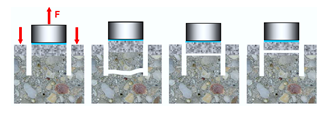Concrete Testing
Credit: 8 PDH Hours
Course Fee: $120.00
68 pages
How it Work!
- Register first and log into your account. Study and take the quiz for FREE until passed.
- After passing the quiz, follow the page, pay for the course and print your certificate.
Course Summary:
In this PDH or CE course student will learn concrete repairing mainly includes removing unsound concrete and replacing it with repair or overlay materials. One of the key requirements for any kind of repair system is to have adequate bond strength between the existing concrete substrate and overlay throughout the service life. When a repair is performed, the differences in the properties of two materials will affect bond strength and stress distribution. Of particular relevance are differences in shrinkage, elastic modulus and thermal movement.

The repair system can be considered as a three phase composite system: substrate, overlay and bond zone. Bond zone here refers to the interface and vicinity of bond plane. The bond zone must be capable of withstanding the stresses imposed on the system. Different factors have effects on the bond strength and its integrity.
The quality assurance of bond strength requires test methods that can quantify the bond strength as well as identify the failure mode. There have been numerous investigations led to development of different test methods. The forces which are applied in each test and the failure mode are important in order to choose the proper test. Tests are defined both in laboratory and field. An interpretive study on test methods is presented which classifies and compares the tests based on the applied force, failure mode and practical importance of each test.
As the failure modes are either in tension or in shear, two test methods are more applicable; first one is “Pull off test” which is a tensile test and it can be performed both in situ and in the lab. The simplicity and accuracy of the test has made it the most popular test method in projects. The second one is “slant shear test”, which has the shear failure mode and it can be done only in the lab. The so called Twist off test is a relatively new test method to appraise the bond strength in the interface. The advantage of the test is the possibility to perform it in the construction site. The test still needs further developments.
Learning Objective:
In this PDH or CE course the learning objective are:
- The importance of bond strength in concrete repair projects
- Various factors influencing interlayer bond strength at the interface of the concrete repairs
- Various test methods to determine the bond strength
- Discussions and comparison of test methods
Review the quiz before studying the course.
Course Content
Course Author: Franco F. Davati, P.E.
Certificate of completion of the course
This course comes with a multiple-choice quiz. You can view the quiz and take the quiz if you are logged in your account. You can take the quiz for this online PDH course as many times until passed. The passing grade is 70% and above. After you pass the quiz simply follow the page, to pay for the course and print your certificate instantly. A copy of the certificate and receipt for this course will always be in your account.
This online PDH course can also be used as a continuing education course for the following.
